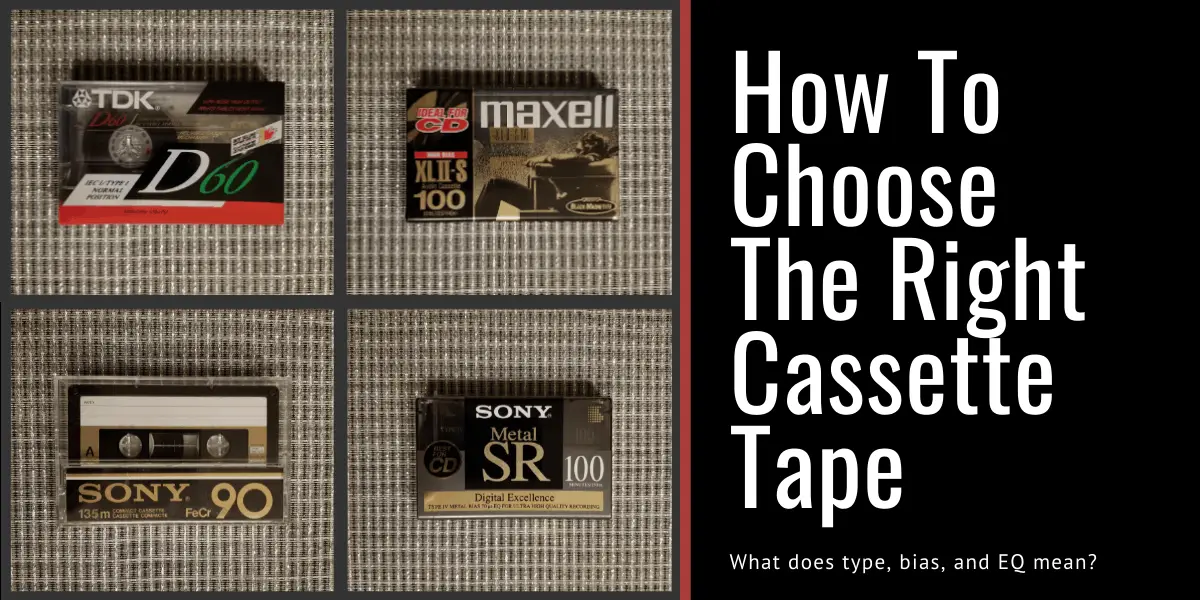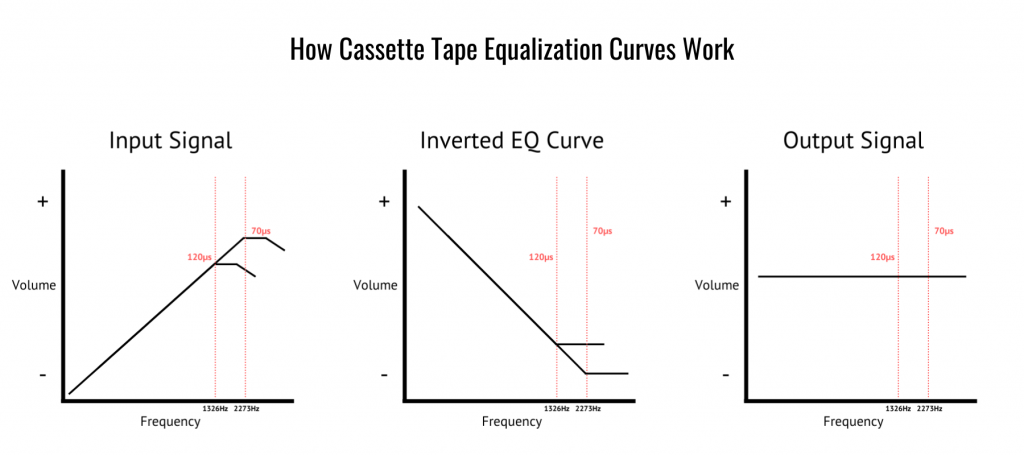The blank cassette tape types you use will have a significant impact on the way your recordings sound. Features like EQ, bias, and tape composition all play a part in achieving the best sound possible from your tapes.
Choosing the right type of cassette tape to record with depends on the specs of your recorder and what sort of sound you want from the recording.
- Ferric – Type I – high hiss, good bass response
- Chrome – Type II – Low hiss, good treble response
- Ferrichrome – Type III – Low hiss, even bass and treble
- Metal – Type IV – Low hiss, balanced frequencies
Let’s take a look at some common questions
- Why Use Cassette Tape For Recording?
- Why Is The Type Of Tape Important?
- Blank Cassette Tape Types
- How To Read The Notches On A Cassette Tape
- What Does Tape Bias Mean?
- What Is Cassette Tape Equalization (120µs/70µs)?
- How Long Do Blank Cassettes Record For?
Want some free cassette tape drum samples? Check out our free sample packs page for some awesome freebies!
Why Use Cassette Tape For Recording?
First things first, why should you record your music onto a cassette tape?
Cassettes sounds awesome
Cassette tape adds a unique texture to your recordings. When you record, your source signal is translated into magnetic patterns which are printed to the tape. Sound is produced when the playback head reads the magnetic information as the tape scrolls past.
To do all of this your cassette deck uses motors and gears to physically move the tape along the heads. All of this sound and activity, while not directly captured in the recording, becomes part of your recording.
In a way your sound almost becomes real and tangible.
Cassettes are inexpensive
Cassette recorders can easily be found at an antique store, a pawn shop, or salvage shop. Online sites like Kijiji and Craiglist frequently have listings for used cassette decks and tapes as well.
We recommend going into either an antique shop or a pawn shop to take a look around. This way you will be able to see what sort of condition the item is in. Most of the time the owners will clean up the units before they put them on the floor.
You should be able to source the entire set up for under $100. Around $80 for the cassette deck and definitely under $20 for some decent used (or new if you’re luck) blank cassette tapes.
Recording to cassette is fun and rewarding
Cassettes were kind of like the introduction to home recording. They were accessible, affordable, and produced a reasonably high quality recording.
Plus, you have a physical and tangible home recording that you can share with your friends (if they still have cassette decks).
Why Is The Type Of Tape Important?
The type of tape you use in your recordings is important for two main reasons: cassette deck compatibility, and creative or personal preference.
Cassette deck compatibility
The type of tape you use has to be compatible with your cassette recorder. If you have an older cassette deck it may not be compatible with a Type IV cassette since they are a relatively new format.
Most decks should have settings for Type I and Type II cassette tapes. Type III is rare and almost never used, more on that below.
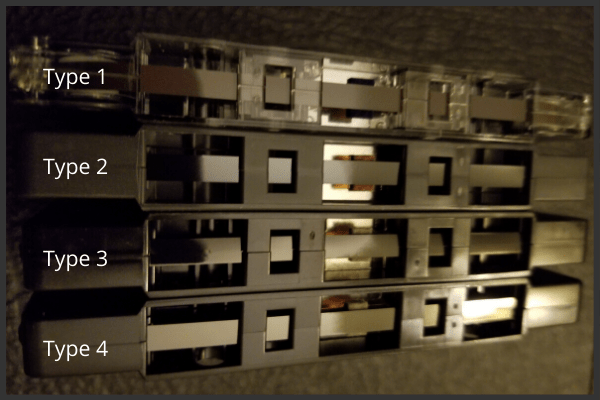
The photo above shows each of the cassette tape types in order starting with Type I. As you can see, the colour of the tape differs between the types.
This is because each type of tape has a different particle make up. The tape compositions also mean the science behind cassette recording (magnetization) happens differently for each tape type.
We’ll discuss each tape type in more detail down below.
You should be able to record to any tape you can fit in your recorder. It just might not sound the best. Feel free to experiment with a cassette that is not compatible with your recorder if that’s your style.
Creative or personal preference
Speaking of style, cassette tape type choice can also be subjective depending on what your sound is. Either you are trying to record as clean as possible or you are trying to achieve a lofi texture.
For those of you trying to capture just a little of that analog tape sound you should look for a Type II or Type IV cassette type. Combine these with a decent cassette deck with the right settings and you’ve got yourself a pretty faithful reproduction of your original.
If you want to add more analog texture and hiss use either a Type I or a Type III. Most cassette decks with automatic type detection will record Type III cassettes with the incorrect Bias and EQ. This results in a Type I-like hiss.
The best way to find the right tape for you is to listen to the characteristics each tape imparts to the source signal.
Let’s have a listen
Side-by-side comparison: Type I, Type II, Type III, Type IV
Here we will take a look at 4 side-by-side comparisons of blank cassette tapes. First we will hear what each tapes hiss sounds like. Then we will compare a full music track, a cheesy drum loops, and a dialogue passage.
Each sample uses the correct settings on the tape deck. The only exception was Type III which used the settings from Type I (due to the notch configuration).
Tapes used:
- Type I – TDK D60
- Type II – Maxell XLiiS 100
- Type III – Sony FeCr90
- Type IV – Sony Metal SR 100
No Dolby reduction was used during recording.
Hiss comparison
Tapes will have their own unique hiss signature depending on the chemical make up of the tape within the cassette. Lets listen to the differences between ours.
Digital (lol)
Type I
Type II
Type III
Type IV
Music comparison
With recorded music we hear a difference in the dynamics. Take a listen for the hiss, do you see where it sits relative to the music in each example?
Digital
Type I
Type II
Type III
Type IV
Drum comparison
This side-by-side demonstrates how prominent the hiss becomes in the space between the drum hits.
If you were to use this drum track in a song and then record the full song to tape again, you would be doubling the hiss. So in this case we would use a noise gate to remove the hiss but keep the analog texture on the drums.
Digital
Type I
Type II
Type III
Type IV
Dialogue comparison
Some tape types also yield better results for dialogue or vocal only performances. Type III is kind of hard to listen to.
Digital
Type I
Type II
Type III
Type IV
As you can hear, each tape type produces a unique sound and characteristic. Let’s take a look at what else makes each type of cassette tape different.
Blank Cassette Tape Types
Blank cassette tape types come in 4 varieties.
As we know, each tape is made of a different chemical composition, but what else makes each type different?
The video above provides a quick explanation of the 3 main cassette tape types. Type III cassettes were left out because they are not often used.
Time for more detail!
Type I – Ferric
Sounds: High hiss, low dynamics, dark, lofi
Cost: $
Bias: Normal
EQ: 120µs
Frequency Response: 30Hz-15,000Hz
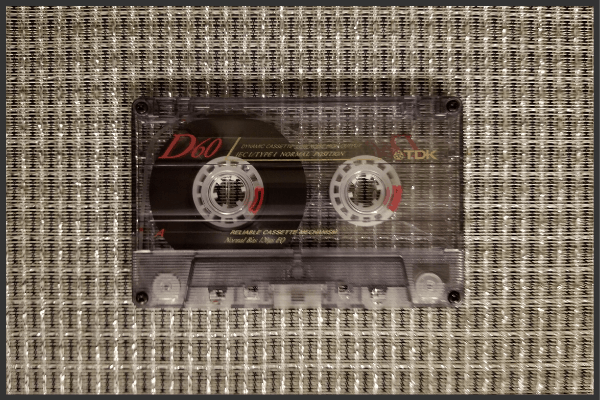
Type 1 cassette tapes, often called “Ferric” or “Normal” tapes, are the most common type of cassette tape. Most cassette recorders and players will play these types of cassettes.
What is the tape made of?
Normal bias type I tape is made of a fine iron oxide particle coating. The iron in the formula gives the tape a distinct brown colour.
Some cassette manufacturers produce what is called “superferric” tapes. These tapes usually have cobalt particles mixed in with the iron oxide. This can give the superferrics more of a blue colour.
Iron oxide tape does a good job at reproducing the bass frequencies but lacks in the highs. This helps contribute to overall lower dynamics. The cobalt in the superferric formulation helps bring back some of those highs.
Characteristics of Type I cassette tapes
You can usually find Type I cassettes for a low cost, we found a handful of them at a record shop for less than 5 bucks. They were definitely used and not all in great condition but they had character.
Although they lack in the dynamics department, Type I tapes sound pretty decent. Especially if lofi is your thing. The high frequencies are rolled off which gives the tape a darker sound.
A broad definition for Type I cassettes would be low quality with high noise.
Ferric cassette tapes have 2 notches at the top of the tape to help the cassette deck identify the type. More on this below.
Examples: Maxell UR, Sony HF, TDK D, Maxell XLI-S, TDK AR-X, Maxell UDI
Type II – Chrome
Sounds: Brighter, low hiss, good dynamics
Cost: $$
Bias: High
EQ: 70µs
Frequency Response: 30Hz-16,000Hz
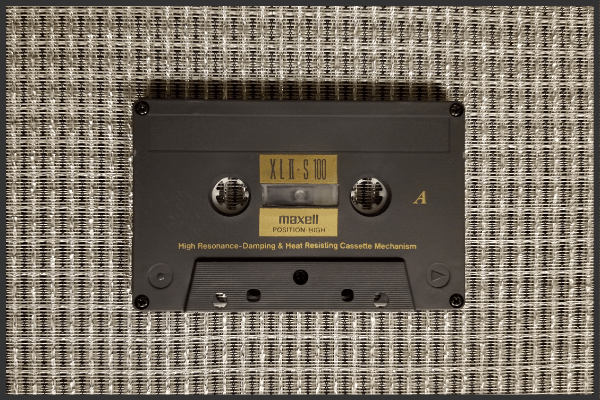
Type II cassettes, also known as “High Bias” or “Chrome” tapes, are the new and improved Type I. They were made to improve on the lack of high frequencies provided by the Normal tapes.
These should also be compatible with most cassette decks you will find around these days.
What is the tape made of?
Chrome tapes are made of just that, Chrome. Well most of them at least. There are 2 varieties of Type II tape.
Pure Chrome tapes are made of chromium dioxide particles or CrO2.
Chrome Doped Ferric tapes are made with a mix of iron oxides and chrome or cobalt.
The chrome gives the tape a blue colour and requires the use of a high bias setting. This helps duplicate more natural sounding high frequencies but comes with a lower bass response. Type II tape also has significantly less hiss than a Type I tape, producing a much cleaner recording.
Characteristics of Type II cassette tapes
Type II cassettes can be found at a pretty low cost either on Amazon or at a record shop. Again, we found a bunch at a record shop for cheap at around $1 a tape.
High bias tapes produce a much more faithful recording due to the lower hiss level. Although the bass response is lacking, we found the accentuated highs to improve the dynamics of our recordings.
The bass really isn’t weak in these, it’s just slightly lower. We like to print our instrument takes on these and then re-record them back into the mix.
There are again 2 notches on these tapes, this time however, the notches are wider and half of each notch is slightly shallower. More on these below.
Examples: BASF Chrome Extra II, Sony CD-IT, Maxell XLII-S, TDK SA
Type III – FerriChrome
Sounds: High hiss, a bit brighter than Type I
Cost: Rare
Bias: High
EQ: 70µs
Frequency Response: 30Hz-16,000Hz
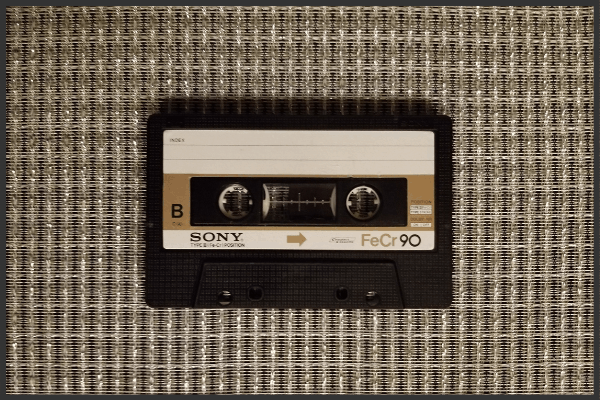
This is the tape you will rarely see, the Type III. These tapes, better known as “FerriChrome” tapes, were invented to combine the best of both the Type I and Type II. Ferrichromes had both great bass response and great treble response.
There was only one problem, some particles required a normal bias and some particles required a high bias. This meant that no matter which bias setting you used, neither was optimal.
Type III tapes never took off with consumers since you needed special bias settings to make them work properly. Most commercial cassette decks only had the 2 bias options.
What is the tape made of?
These tapes are made of a mix of iron and chrome coating which means their bias must be somewhere between normal and high. Sometimes rather than a mix these tapes will be a ferric base with a chrome top layer.
Type III cassette tape types will have a dark mix of brown and blue, almost black coloured tape.
When recorded and played with the correct bias ferrichromes produce a faithful recording with good bass and treble response.
Characteristics of Type III cassette tapes
The downside to Ferrichrome tapes is that it is hard to find a cassette deck with the appropriate bias settings. Since the ferrichrome tapes have only 2 notches up top, you bias them just like a Type I tape on automatic cassette decks. If you are lucky enough to have a cassette deck with a bias adjustment knob you should be able to dial in the correct bias for these tapes.
Ferrichromes are hard to find tapes and thus come with a higher price tag. New Type III tapes in the original packaging are pretty rare and are usually worth quite a bit. This makes recording with Type III tapes cost prohibitive unless you are able to find some good condition used tapes.
Type III cassette tapes have a low level of hiss (noise) when they are recorded with the correct bias settings. However, when played with Type I settings the sound is much closer to a Type I tape with brighter highs.
Examples: Sony FeCr, BASF Ferrochrom
Type IV – Metal
Sounds: Lowest hiss, good dynamics, good lows and highs
Cost: $$$
Bias: Higher
EQ: 70µs
Frequency Response: 30Hz-16,000Hz
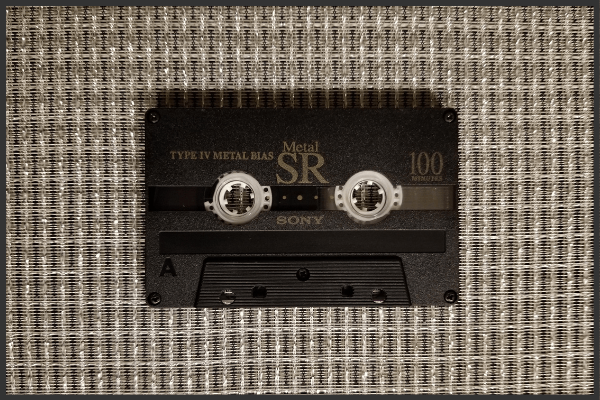
Despite the name of these tapes, they are not just for recording metal. Type IV tapes, otherwise known as “Metal” tapes were the top of the line for clear cassette tape recording. Paired with a decent cassette recorder, these cassette tape types came the closest to matching digital recordings.
What is the tape made of?
Metal formulated cassette tapes are made with metal particles bonded to the tape. Type IV’s could produce accurate treble and low frequencies at a much higher input level than the other types of tapes. The metal particles in the tape however were often responsible for early wear on a cassette decks play and record heads.
The Type IV tape has a shiny metallic look to it as one would expect. They also record at a slightly higher bias than the Type II tapes.
Characteristics of Type IV cassette tapes
Metal cassette tape types are the most expensive tapes available. The metal particles meant the tape was more robust and often lasted for a long time. People would use these tapes to record albums they planned on having for a long time.
Originally developed for studio and live applications, these tapes will produce a low noise recording with balanced treble and bass response. As you can hear above, metal tapes sound closest to a digital recording.
If your goal is to use cassette tapes to add character to your music, we don’t recommend using Type IV cassette tapes. They are simply too clean and too expensive for this process. Stick with a Type I or Type II tape.
The 4 notches found at the top of a metal cassette are the easiest way to identify the tape type. The notches on the outside of the tape tell the cassette deck to use the bias of a Type II tape. The notches on the inside of the cassette tell the player to push the bias even further! Metal tapes have the highest bias requirement of all the cassette tape types.
Examples: Maxell MX, Sony Metal SR, TDK MA, BASF Metal
How To Read The Notches On A Cassette Tape
The notches on the cassette tapes tell the cassette player which EQ and bias settings to use.
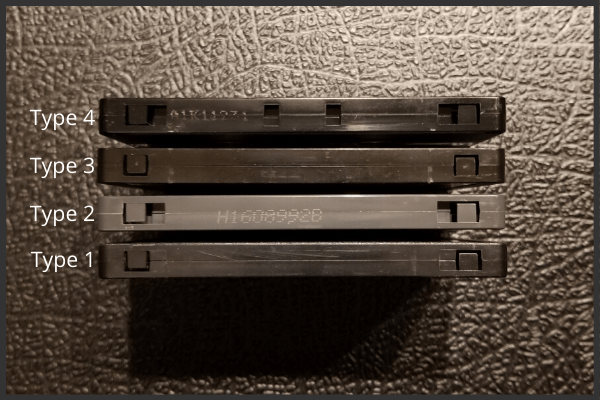
Type I cassettes only have 2 write protection notches at the top of the tape.
Type II cassettes have 2 write protection notches as well as 2 notches to tell the cassette player which EQ/bias to use.
Type III cassettes use the same set up as type I tapes, only the write protection tabs are there.
Type IV cassettes have a third set of holes located towards the center of the tape. The middle notches are there to tell the cassette deck to use an even higher bias than type II tapes.
Write protection
If the write protection notches are covered the cassette is recordable. When the notches at the top are opened the cassette is write protected.
If your tape has the write protection tabs knocked out and you want to record onto the tape, just cover the holes with a piece of tape.
EQ/Bias Notches and Tape: It is important to make sure you only cover the write protection portion of the notches with tape. If you cover the other notches the cassette deck won’t choose the correct EQ/Bias settings.
What Does Tape Bias Mean?
Bias refers to the addition of an electrical signal when recording to a cassette tape. This signal, usually somewhere between 60KHz and 430KHz, helps the cassette recorder capture the input signal with as little distortion as possible.
The correct bias will also help record a more linear frequency response which provides more balance between the low and the high frequencies.
Each of the types of cassette will have their own bias setting, usually either “Normal Bias” or “High Bias”. These may also be written as “Normal Position” or “High Position”
Most cassette decks will detect the tape bias automatically but if you have a high end cassette recorder you may need to calibrate the bias to match your tape. But that is a topic for another day!
What Is Cassette Tape Equalization (120µs/70µs)?
Cassette tapes are printed with magnetic patterns that represent the frequencies of the recorded audio.
The magnetic patterns representing the high frequencies generate more voltage than the low frequencies. This results in a volume increase as we move towards the top end of the spectrum.
Cassette tape equalization is the tool we use to balance this volume increase. The playback signal path will generate an inverted EQ curve to balance out the louder frequencies.
This will help produce a more flat frequency response line.
What does 70µs and 120µs mean?
Microseconds are used to denote where on the frequency spectrum the EQ correction levels out. In cassette tape technology we use 70µs and 120µs depending on the type of cassette tape you are using.
Type 1 cassette tapes will have a time constant of 120µs which starts the EQ levelling at around 1326Hz.
Chrome, FerriChrome, and Metal tapes use a time constant of 70µs (sometimes higher with Metal tapes) which starts the EQ levelling at around 2273Hz.
Cassette tapes with a time constant of 70µs will generally provide around a 4.5db reduction in tape hiss.
How Long Do Blank Cassettes Record For?
The tape length of a blank cassette is measured by total playback time. The playback time will usually be included in the tape model name.
For example: TDK D-60 (60 minutes), Maxell UDII100 (100 minutes)
Common tape lengths are 60 minute, 90 minute, 100 minute, and 120 minutes.
Due to the compact size of the cassette tape, the amount of tape that can be stored inside is limited. This means that in order to fit more tape in the cassette, the tape must become thinner. Thinner cassette tape is less durable and more likely to break inside the tape.
Which Blank Cassette Type Will You Use?
Hopefully you now have a better understanding of the different types of blank cassette types available. The best way to find your sound is to experiment, so find some new or used tapes and start recording!
Have fun!
Additional Resources
- Tape Tardis – https://tapetardis.wordpress.com/2012/04/24/the-type-iv-metal-audio-cassette/
- Instructables – https://www.instructables.com/id/Cassette-Tape-1101-an-in-depth-look-into-this-an/
- How Stuff Works – https://electronics.howstuffworks.com/gadgets/audio-music/cassette3.htm
Author: Mike P
Hi! My name is Mike! I’ve been an apartment producer/musician for 10+ years. I’ve played in punk bands, released EDM tunes on Beatport and iTunes, and have a semi-successful stock music portfolio. Read more…


